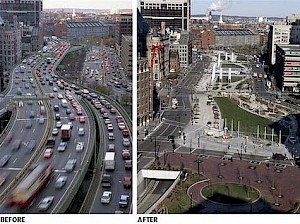Happening Now
Vision
January 24, 2019
by Joe Aiello | Northeast Field Coordinator
“It’s just easier to drive!”
“We don’t need another ‘Big Dig’!”
“Tommy Brady is the greatest eva, kehd!”
I hear statements like this nearly everyday (one of them I hear WAY too much). It’s part of the mentality that us advocates need to break when talking to the general public about transportation needs. The “Big Dig” comment comes my way nearly daily when trying to discuss the North-South Rail Link - the project that would connect North & South Stations in Boston, allowing for uninterrupted service between Virginia and Maine (Jim Mathews wrote a great blog on this topic in December). Was the “Big Dig” an over promised and over budget boondoggle at the time? Yes. But would anyone go back to the way things were before the Central Artery was put underground? Not a chance.
Not every improvement is on this scale.
In my blog two weeks ago, “Time To Rip Off The Band-Aid”, I talked about the sacrifices that must be made by everyone when it comes to infrastructure projects that would improve public transit. But what types of improvements can be made? New York talks about needing tunnel work due to years of weather damage and underfunding. What else is out there? A good example of this is the current Rail Vision process being done by MassDOT and the MBTA - but “what will it cost us?” seems to remain their biggest hurdle.
Our friends at TransitMatters created a Regional Rail paper that outlines many of these issues from the advocacy side: standard high platforms, new DMU/EMU train sets, electrifying the system, fare integration - all with the hopes of creating a high-frequency, all-day service that gets more people out of their cars. Those are universal ideas that nearly every metro transit area in this country should be working on. Miami, DC, Chicago, Los Angeles… the list goes on and on.
There is also the issue of “how do we pay for it?”. Seattle recently passed Proposition 1, also known as “Sound Transit 3”, which proposed an increase in property, sales and car-tab taxes, to support $54 billion in regional projects over 25 years. I know that BILLION is a scary word when it comes to funding costs for anything - but a volunteer group named Seattle Subway tried to help break that thinking through innovative street art. The idea isn’t to think of this as “it’s HOW much money?” and more of “I will be HOW close to a transit stop?”
The MBTA’s Rail Vision, as I mentioned above, is currently looking at six “service alternatives” to transform the existing commuter rail network as part of a larger “what should the system look like in 2040 and beyond?” scope. Only one of these alternatives, alternative #6 to be exact, calls for full expansion (South Coast Rail, North-South Rail Link), electrification, 15 min all-day frequencies, and EMU train sets - all the things that advocates have been fighting for.
Only one.
If “everything and the kitchen sink” isn’t our ultimate transit goal? Then what are we even doing here?
It’s “National or Nothing” on a local scale.
That’s vision.
"It is an honor to be recognized by the Rail Passengers Association for my efforts to strengthen and expand America’s passenger rail. Golden spikes were once used by railroads to mark the completion of important rail projects, so I am truly grateful to receive the Golden Spike Award as a way to mark the end of a career that I’ve spent fighting to invest in our country’s rail system. As Chair of the Transportation and Infrastructure Committee, it has been my priority to bolster funding for Amtrak, increase and expand routes, look to the future by supporting high-speed projects, and improve safety, culminating in $66 billion in new funding in the Bipartisan infrastructure Law."
Representative Peter DeFazio (OR-04)
March 30, 2022, on receiving the Association's Golden Spike Award for his years of dedication and commitment to passenger rail.


Comments